Welcome to the Ultimate Guide to Outdoor Games for Kids! In today’s digital age, where screens and devices often dominate children’s leisure time, it is more important than ever to encourage them to engage in active and fun play outdoors.
Outdoor games not only provide a break from sedentary activities but also offer numerous physical, mental, and social benefits for children.
This comprehensive guide aims to inspire parents, guardians, and caregivers with a wide array of exciting game ideas that will keep kids entertained, active, and stimulated. Whether you’re planning a backyard playdate, a family gathering at the park, or a summer camp adventure, this guide has you covered.
No matter the season or the setting, outdoor games offer children the opportunity to connect with nature, explore their surroundings, and enjoy the fresh air. They provide a break from the structured routines of daily life and allow children to unleash their energy and creativity in a safe and enjoyable manner.
Outdoor games play a vital role in the physical, mental, and social development of children. In an age dominated by technology and sedentary lifestyles, the significance of outdoor activities cannot be overstated.
Engaging in sports and games under the open sky not only promotes physical fitness but also enhances cognitive skills, instills social values, and fosters a sense of adventure and exploration in children.
In this modern era, where digital devices have become ubiquitous, it is crucial to recognize the importance of outdoor games for kids and encourage them to step out of their comfort zones and embrace the wonders of the great outdoors.
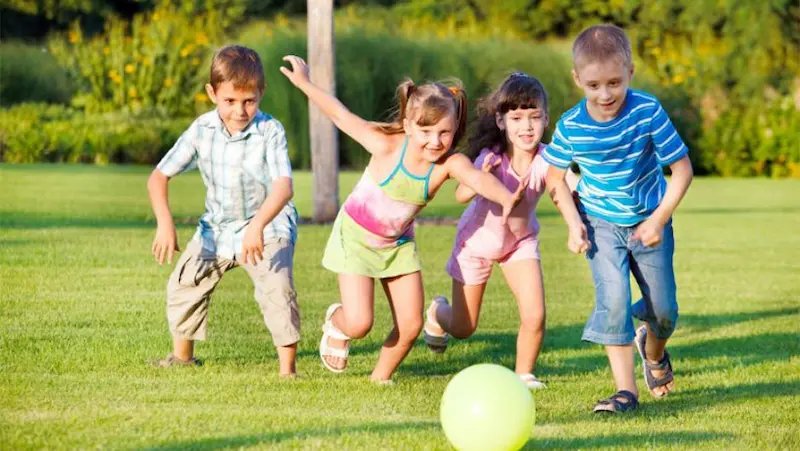
So, whether you’re a parent looking for ways to keep your children active during the weekends or a teacher searching for engaging activities for your students, this Ultimate Guide to Outdoor Games for Kids to play will be your go-to resource.
Get ready to create lasting memories and provide children with an enriching playtime experience that will leave them with a love for the great outdoors. Let the games begin!
Table of contents
Benefits of physical activity and outdoor play
In our increasingly sedentary and technology-driven world, it is crucial to emphasize the importance of physical activity and outdoor play for individuals of all ages. Engaging in regular physical activity and spending time outdoors offers a multitude of benefits for our physical, mental, and emotional well-being.
The advantages are remarkable, from enhancing physical fitness to improving cognitive function. In this blog, we will explore some key benefits of physical activity and outdoor play, highlighting why incorporating them into our lives is essential.
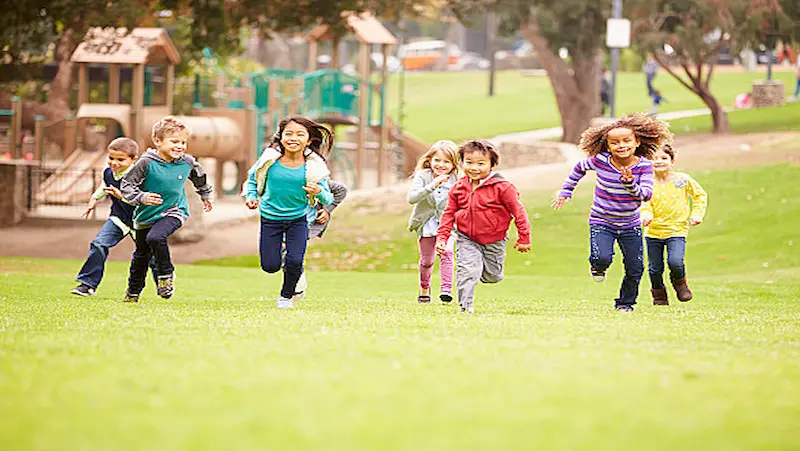
Improved Physical Health:
Physical activity and outdoor play provide numerous health benefits. Regular exercise helps to maintain a healthy weight, reduce the risk of chronic diseases (such as cardiovascular disease, diabetes, and certain types of cancer), and strengthen bones and muscles.
Outdoor play, whether it involves running, cycling, or playing sports, increases cardiovascular endurance and improves overall fitness levels. Engaging in physical activity also helps in maintaining flexibility, balance, and coordination, promoting a healthier and more active lifestyle.
Mental and Emotional Well-being:
Physical activity and outdoor play have a profound impact on mental and emotional well-being. Exercise stimulates the release of endorphins, often referred to as “feel-good” hormones, which can help alleviate stress, anxiety, and depression.
Spending time outdoors, particularly in natural environments, has been shown to reduce feelings of fatigue and boost mood and self-esteem. Exposure to natural light and fresh air enhances cognitive function, increases energy levels, and fosters a greater sense of happiness and well-being.
Cognitive Development and Academic Performance:
Physical activity and outdoor play positively influence cognitive development and academic performance, particularly in children. Regular exercise has been linked to improved attention span, enhanced memory, and increased creativity.
Outdoor play provides opportunities for problem-solving, critical thinking, and imaginative play, which contribute to cognitive development. Research indicates that children who engage in physical activity and outdoor play often exhibit better academic performance, concentration, and classroom behavior.
Social Interaction and Communication Skills:
Engaging in physical activity and outdoor play promotes social interaction and the development of communication skills. Team sports, group activities, and outdoor games encourage collaboration, cooperation, and the ability to work effectively within a team.
Outdoor play environments also provide opportunities for children and adults to meet new people, make friends, and develop social skills. This fosters a sense of belonging, enhances interpersonal relationships, and improves overall social well-being.
Connection with Nature and Environmental Awareness:
Outdoor play allows individuals to connect with nature and develop a greater appreciation for the environment. Spending time outdoors exposes us to natural elements, such as plants, animals, and landscapes, fostering a sense of wonder and curiosity.
This connection with nature promotes environmental awareness, leading to increased conservation efforts and a desire to protect the natural world. Engaging in physical activity outdoors can also serve as a reminder of the importance of preserving green spaces and encourages a more sustainable lifestyle.
Age-Appropriate Outdoor Games
Childhood is a time of exploration, growth, and boundless energy. Outdoor games play a crucial role in the physical, cognitive, and social development of children. However, it is important to choose games that are suitable for each age group.
In this blog, we will explore age-appropriate outdoor games for preschoolers (2-5 years), primary school children (6-12 years), and teenagers (13+ years). We’ll provide game ideas, rules, and variations to keep children engaged, active, and entertained.
Section 1: Preschoolers (2-5 years)
Preschoolers are full of curiosity and enthusiasm. They are developing their motor skills and coordination. Here are some outdoor game ideas that are perfect for this age group:
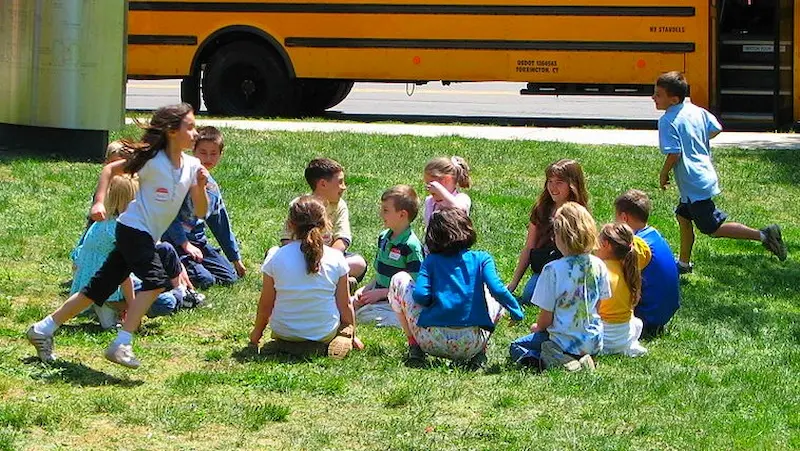
Duck, Duck, Goose
This classic game is perfect for preschoolers. Have the children sit in a circle, and one child walks around tapping each child on the head saying, “Duck.” Eventually, they tap a child and say, “Goose.” The “goose” then chases the first child around the circle, trying to tag them before they reach the vacant spot. If the first child gets tagged, they become the new “goose.”
Simon Says
Simon Says is a great game for improving listening skills and following directions. The leader (Simon) gives commands starting with “Simon says,” such as “Simon says touch your nose” or “Simon says hop on one foot.” The children must only follow the commands that begin with “Simon says.” Anyone who follows a command without “Simon says” is out. The last child remaining becomes the new Simon.
Section 2: Primary School Children (6-12 years)
Primary school children have more developed motor skills and enjoy games that involve strategy and teamwork. Here are some outdoor game ideas for this age group:
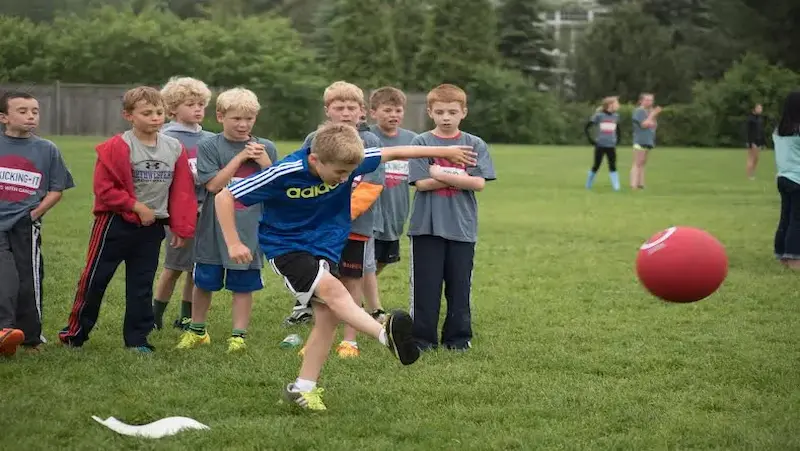
Capture the Flag
Divide the children into two teams and designate each team’s territory. Each team hides its flag in its territory. The objective is to capture the opposing team’s flag and bring it back to your territory without being tagged. If a player is tagged, they are out and must go to a designated area. A teammate can free them by touching them. The team that successfully captures the flag the most times wins.
Kickball
Similar to baseball, kickball is a popular game among primary school children. Set up bases and divide the children into two teams. The team at bat kicks a large rubber ball and runs around the bases, while the fielding team tries to catch the ball and tag the runners out. Each player must kick the ball and then run to the next base. The team with the most runs wins.
Section 3: Teenagers (13+ years)
Teenagers seek more challenging and competitive outdoor games that cater to their growing strength, coordination, and social skills. Here are some game ideas for teenagers:
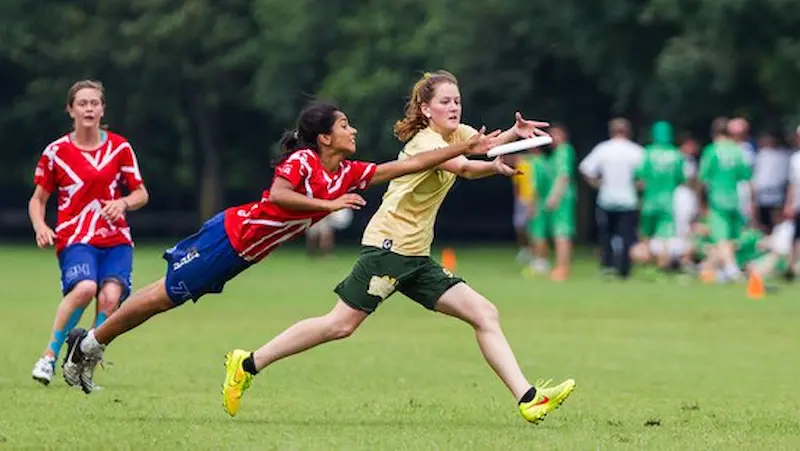
Ultimate Frisbee
Ultimate Frisbee combines elements of soccer and football. Create two teams and mark end zones. The objective is to pass the Frisbee to teammates until they catch it in the opposing team’s end zone to score a point. Players cannot run while holding the Frisbee but can pivot on one foot. If the Frisbee hits the ground or is intercepted, the opposing team gains possession.
Outdoor Scavenger Hunt
Organize an outdoor scavenger hunt to challenge teenagers’ problem-solving abilities and teamwork. Create a list of items or clues that need to be found within a specified area. Divide the teenagers into teams and provide each team with a copy of the list. The team that finds all the items or solves all the clues in the shortest time wins.
Skill-Building and Educational Outdoor Games
In the digital age, where children are often immersed in screens and virtual experiences, it’s crucial to encourage them to engage in outdoor activities that foster learning, problem-solving, teamwork, and physical exercise.
Skill-Building and Educational games for kids provide a fantastic opportunity to combine fun and learning, allowing children to develop important skills while enjoying the great outdoors. In this blog, we will explore a variety of games that incorporate educational elements, highlighting their benefits and explaining how to incorporate them into your child’s playtime.

Scavenger Hunt
Scavenger hunts are an exciting way to boost problem-solving skills and encourage teamwork. Create a list of items or clues that the players need to find within a defined area, such as a park or backyard. You can tailor the scavenger hunt to focus on various subjects, such as nature, history, or even math problems.
For example, you can ask players to find specific leaves, identify different bird species, solve riddles, or locate historical landmarks. Scavenger hunts promote critical thinking, observation, communication, and collaboration.
Outdoor Math Games
Mathematics can be brought to life through engaging outdoor games. Incorporate math concepts like addition, subtraction, multiplication, and division into games like “Number Hopscotch” or “Math Relay Race.” For Number Hopscotch, draw a hopscotch grid on the ground and replace the numbers with math problems.
As children jump on each number, they must solve the corresponding math problem. Math Relay Race involves dividing players into teams. Each team is given a set of math problems, and players must solve them correctly to move forward in the race. These games enhance numeracy skills, mental math, and quick thinking. Check out online games for kids.
Plant and Animal Identification
Nature exploration games offer an excellent opportunity for children to learn about plants, animals, and ecosystems. Create a “Nature Bingo” card games for kids featuring different plants, insects, or animals commonly found in your area. Encourage children to observe their surroundings and mark off each item as they spot it.
You can also organize a “Tree Identification” game where participants learn to recognize different tree species based on their leaves, bark, or shape. These games enhance observation skills, scientific knowledge, and an appreciation for the natural world.
Team-Building Obstacle Course
Designing and completing a team-building obstacle course promotes problem-solving, physical fitness, and teamwork. Set up various challenges like crawling under a rope, balancing on beams, or solving puzzles along the way.
To incorporate educational elements, include stations where participants must solve math problems, answer trivia questions, or complete word puzzles before moving on to the next obstacle. This encourages collaboration, critical thinking, and communication while keeping the physical aspect of the game engaging.
Geography Relay
Geography Relay is a game that combines physical activity and geographical knowledge. Divide players into teams and set up markers representing different countries or landmarks in a large outdoor area.
Each team member must run to a marker, identify the corresponding country or landmark, and return to the team to tag the next player. To incorporate learning games for kids and to provide additional information about each location, such as interesting facts or cultural trivia. This game improves geographical knowledge, quick thinking, and teamwork.
Classic and Traditional Outdoor Games
In a world filled with digital entertainment and ever-evolving technology, it’s easy to overlook the simple joys of traditional games that have brought countless generations together. The timeless games we played as children, like tag, hide-and-seek, and hopscotch, hold a special place in our hearts.
In this blog, we will take a trip down memory lane and revisit these classic games. We will delve into the rules, variations, and nostalgic aspects that make them such enduring favorites.
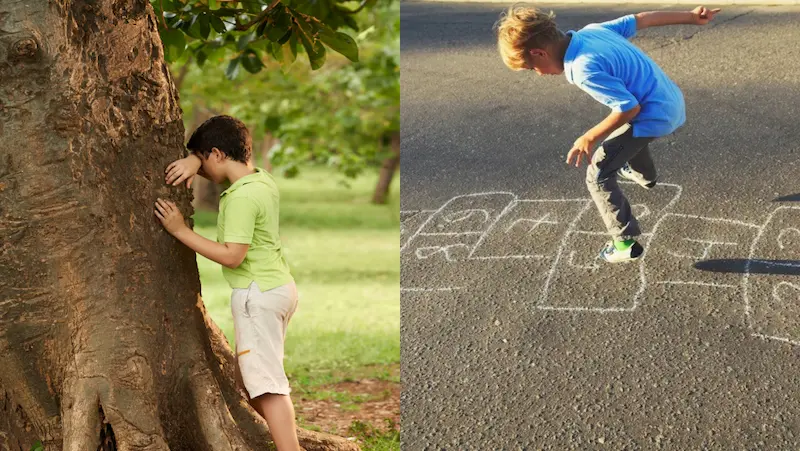
Tag
Tag is a game that transcends cultural boundaries and has been played by children across the globe for centuries. The premise is simple: one person is designated as “it,” and they must chase and touch another player to pass on the role. The game continues until everyone has been tagged or until players agree to end it.
Variations:
Freeze Tag: When tagged, players must freeze in place until they are unfrozen by another player.
Shadow Tag: Instead of touching, players tag each other by stepping on each other’s shadows.
TV Tag: Players must freeze and imitate a television character when tagged until they are unfrozen.
Nostalgic Aspects:
Tag invokes feelings of sheer joy, adrenaline, and camaraderie. The thrill of chasing and being chased, the sound of laughter echoing through the air, and the exhilaration of narrowly escaping capture create lasting memories that bring us back to carefree childhood days.
Hide-and-Seek
Hide-and-seek is a game that combines the thrill of hiding with the anticipation of being found. It sparks the imagination and tests our stealth skills as we search for the perfect hiding spot.
Rules:
1. One person is chosen as the seeker while the rest hide.
2. The seeker counts to an agreed-upon number (e.g., 30) with their eyes closed while the others find hiding spots.
3. Once the counting is complete, the seeker begins searching for the hidden players.
4. The game ends when all the players are found, and a new seeker is chosen for the next round.
Variations:
Sardines: One person hides, and as others find them, they join the hiding spot until only one seeker remains.
Flashlight Hide-and-Seek: Played in the dark, the seeker uses a flashlight to find hidden players.
Statues: When found, players freeze in place and can only resume hiding once the seeker moves away.
Nostalgic Aspects:
The anticipation of finding the perfect hiding spot, the silent adrenaline rush as the seeker comes closer, and the satisfaction of staying hidden until the end all contribute to the nostalgic charm of hide-and-seek. The game fosters a sense of adventure, strategy, and the joy of discovery.
Hopscotch
Hopscotch is a game that combines physical activity with mental agility. It challenges players to hop through a numbered grid while avoiding stepping on the lines.
Rules:
1. Draw a grid on the ground with numbered squares.
2. Players take turns throwing a small object (e.g., a stone or beanbag) into the first square.
3. The player then hops through the grid, skipping the square with the object.
4. On the return trip, players must pick up the object without losing balance or stepping on the lines.
5. If successful, the player continues to the next numbered square.
6. If a player steps on the line, loses balance, or fails to retrieve the object, their turn ends, and the next player goes.
Variations:
Double Dutch Hopscotch: Incorporates jump rope into the game, requiring players to hop through the grid while jumping rope.
Spiral Hopscotch: Instead of a square grid, the squares form a spiral, adding an extra challenge to the game.
Nostalgic Aspects:
The rhythmic hopping, the satisfying sound of the object landing in the square, and the elation of successfully completing each round of hopscotch fill us with fond memories. The game promotes balance, coordination, and friendly competition while immersing us in a world of imaginative play.
Water-Based Outdoor Games
As the scorching summer heat arrives, finding ways to stay cool and have fun becomes a top priority. Water-based outdoor games offer the perfect solution, providing an exciting way to beat the heat while engaging in physical activities.
Whether you’re planning a pool party, beach outing, or simply enjoying your backyard, these games are sure to make a splash. In this blog, we will explore a variety of water games suitable for hot weather, along with essential safety tips and fun ways to cool off.
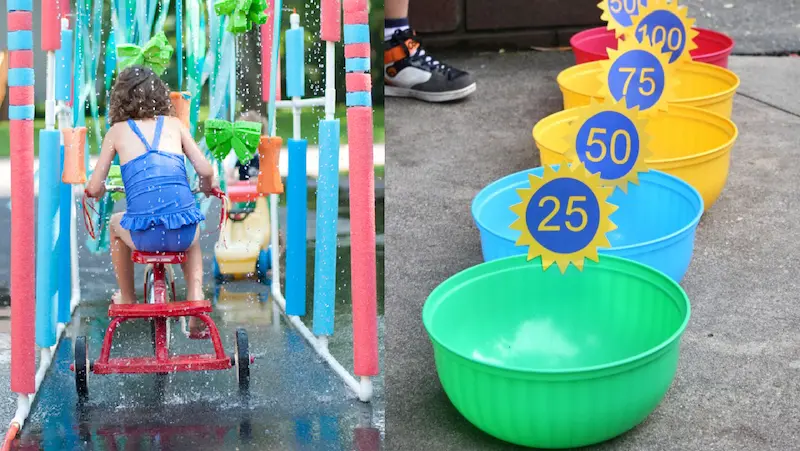
Water Balloon Toss
Water balloon toss is a classic game that never fails to bring laughter and refreshment to a hot summer’s day. To play, fill several balloons with water and create pairs of participants. Each pair stands a few feet apart and tosses the balloon back and forth.
The catch is to take a step back after each successful catch, increasing the distance. The last pair with an intact balloon wins! Remember to clean up any broken balloons to keep the playing area safe.
Sprinkler Limbo
A unique twist on the traditional limbo game, sprinkler limbo combines the joy of dancing and water play. Set up a sprinkler to create a refreshing curtain of water, adjusting the height based on the participants’ ages and abilities.
Play some lively music and have each player take turns limboing under the sprinkler stream. Lower the height after each successful round, and the last person to make it under the lowest point wins. Ensure a soft landing surface to prevent injuries.
Water Gun Tag
Water gun tag is a thrilling game that provides both excitement and a cool-down effect. Equip each participant with a water gun or water blaster, and designate one person as the “tagger” who carries a sponge or a water-soaked cloth.
The tagger tries to tag other players by touching them with the wet sponge, while the other players attempt to defend themselves by squirting water at the tagger. The last person tagged becomes the new tagger. Set boundaries to ensure a safe play area.
Slip ‘N Slide
The Slip ‘N Slide game is a classic that guarantees hours of wet and wild fun. Set up a long plastic sheet with water running down its length. Participants take turns sliding down the slippery surface, reaching the end with a big splash.
Ensure a soft landing area and place the slide on a grassy or sandy surface for added safety. Always supervise younger children to avoid any mishaps.
Beach Volleyball
Beach volleyball is an excellent water-based game that combines teamwork, strategy, and physical exercise. Find a suitable beach or set up a volleyball net in your backyard. Divide players into teams and start a friendly match.
The added bonus of playing in the water or sand helps keep everyone cool and provides a refreshing break during intense rallies. Remember to drink plenty of water and apply sunscreen to protect against the sun’s rays.
Safety Tips for Water-Based Games:
1. Supervision: Always have adult supervision, especially when children are playing water games.
2. Swimming Skills: Ensure that participants have basic swimming skills or provide appropriate floatation devices for those who need them.
3. Hydration: Remind players to drink plenty of water to stay hydrated, even if they’re having fun in the water.
4. Sun Protection: Apply sunscreen before playing and reapply regularly to protect against harmful UV rays. Encourage participants to wear hats and sunglasses as well.
5. Clear Play Area: Remove any obstacles, such as sharp objects or debris, from the play area to prevent injuries.

Fun Ways to Cool Off:
1. Frozen Treats: Prepare refreshing snacks like popsicles, ice cream, or frozen fruit to enjoy during breaks.
2. Watermelon Eating Contest: Organize a watermelon-eating contest, where participants race to devour the juicy fruit. The water content in watermelon also helps to keep everyone hydrated.
3. Water Relay Race: Set up a relay race that involves filling cups or buckets with water and passing them down the line. The team that fills their container first wins!
4. DIY Water Park: Transform your backyard into a mini water park by setting up a slip ‘n slide, inflatable pool, or sprinklers for endless fun.
DIY Outdoor Game Ideas
Spending time outdoors is not only refreshing but also offers an excellent opportunity to engage in fun activities with family and friends. While traditional outdoor games like tag, hide-and-seek, and frisbee are always enjoyable, why not take it up a notch and try some DIY outdoor games?
DIY game projects not only encourage creativity but also provide a chance to customize and personalize your gaming experience. In this blog, we will explore some exciting DIY outdoor game ideas that will add a touch of uniqueness to your outdoor gatherings.
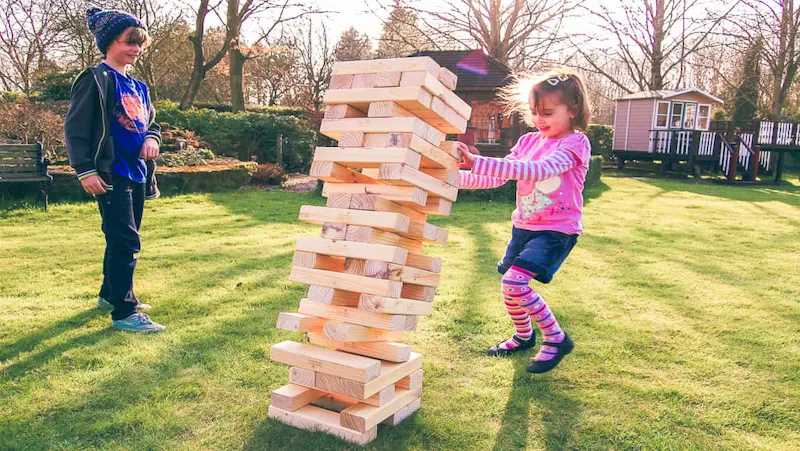
Giant Jenga
Bring the classic Jenga game to life by creating a giant-sized version. Start by cutting wooden blocks into equal sizes and sanding them down to ensure a smooth finish. Stack the blocks in a tower formation, and voila! You have your very own giant Jenga set. This game is not only entertaining but also tests your balance and precision as you carefully remove blocks without causing the tower to tumble.
Bean Bag Toss
Also known as cornhole, this game is a crowd favorite at picnics and backyard parties. Create your own bean bag toss set by making two angled wooden boards with a hole near the top. Paint the boards with vibrant colors and decorate them according to your preference.
For the bean bags, sew fabric squares together, fill them with dried beans or corn kernels, and sew them shut. Set up your bean bag toss game and let the fun begin as players aim to throw their bean bags through the holes for points.
Lawn Twister
Turn your lawn into a colorful Twister board using spray paint. Start by creating circles on the grass, similar to the Twister mat layout. Use different colors to represent different body parts or have multiple players and assign each player a color.
Then, let the twisting and stretching begin as participants try to keep their balance and avoid falling over. This DIY game is sure to bring laughter and excitement to any outdoor gathering.
Ring Toss
Challenge your aiming skills with a homemade ring toss game. Collect a set of glass bottles or other sturdy objects and arrange them in a desired formation. Make rings out of rope or plastic tubing, and paint them in vibrant colors for easy visibility.
Players take turns tossing the rings, aiming to land them around the bottlenecks. You can also assign different point values to each bottle to add a competitive element to the game.
Outdoor Bowling
Transform your backyard into a bowling alley by creating your own outdoor bowling game. Collect empty plastic bottles and fill them with a bit of water or sand to weigh them down. Decorate the bottles with colorful paint or duct tape to give them a personalized touch.
Set up the bottles in a triangle formation, similar to traditional bowling pins, and use a rubber ball as the bowling ball. Roll the ball and aim to knock down as many pins as possible in each turn.
Safety Tips and Precautions
Outdoor play is an essential part of a child’s development, providing numerous benefits such as physical fitness, social interaction, and cognitive growth. However, it’s crucial to prioritize safety when engaging in outdoor activities.
By following a few simple guidelines and taking necessary precautions, we can ensure that children have a fun and safe time exploring the great outdoors. In this blog, we will discuss important safety tips and precautions to keep in mind for a secure outdoor play experience.

Choose age-appropriate activities and equipment
When planning an outdoor play, it’s vital to consider the age and abilities of the children involved. Select activities and equipment that are suitable for their developmental stage. Ensure that the playground or play area is designed with age-appropriate features, such as safe climbing structures, soft surfacing, and adequate fencing to prevent access to roadways or other hazards.
Conduct a safety check
Before allowing children to play outside, conduct a thorough safety check of the play area. Remove any potential hazards such as sharp objects, broken equipment, or debris. Inspect the playground for loose bolts, splinters, or rusty equipment that could cause injuries. Additionally, check the surrounding environment for any poisonous plants or dangerous wildlife.
Encourage the use of protective gear
When participating in activities such as biking, rollerblading, skateboarding, or scootering, it’s crucial to emphasize the use of appropriate protective gear. Helmets, knee pads, elbow pads, and wrist guards should be worn at all times to minimize the risk of head injuries, fractures, or abrasions. Ensure that the protective gear fits properly and is in good condition.
Educate about traffic safety
If the outdoor play area is near roadways or if children will be biking or walking to the park, it’s essential to educate them about traffic safety. Teach them basic road rules, such as looking both ways before crossing the street, using designated crosswalks, and following traffic signals. Encourage them to wear bright or reflective clothing when playing near roads and remind them to never chase after balls or toys that roll into traffic.
Stay hydrated and protect against the sun
Outdoor play can be physically demanding, particularly during hot weather. Ensure that children drink plenty of water before, during, and after playtime to stay hydrated. Apply sunscreen with a high SPF to protect against harmful UV rays, even on cloudy days. Encourage wearing wide-brimmed hats and lightweight, breathable clothing to shield against excessive sun exposure.
Supervise and promote safe play
Proper supervision is crucial to maintaining a safe outdoor play environment. Assign responsible adults or caregivers to keep a watchful eye on children, especially when engaging in activities that involve height or water. Encourage children to play cooperatively, resolving conflicts peacefully and respecting each other’s boundaries. Educate them about potential risks and help them develop a sense of responsibility for their own safety.
Conclusion
In conclusion, it is vital for parents to prioritize outdoor playtime for their children. In today’s modern world, where technology dominates much of our daily lives, it is easy for children to become engrossed in screens and sedentary activities. However, the benefits of outdoor play cannot be overstated.
Firstly, outdoor play promotes physical health and well-being. It allows children to engage in physical activities, such as running, jumping, climbing, and biking, which are essential for their growth and development.
Regular outdoor play helps children build strong muscles, improve coordination, and enhance their overall fitness levels. It also reduces the risk of obesity and related health problems that can arise from a sedentary lifestyle.
Secondly, outdoor play fosters cognitive development. When children play outdoors, they are exposed to various stimuli, such as nature, weather changes, and diverse sensory experiences. These experiences stimulate their senses and promote brain development, leading to enhanced cognitive abilities, problem-solving skills, and creativity.
Outdoor play also encourages imagination and exploration, as children have the freedom to create their own games, scenarios, and stories.
In light of these numerous benefits, it is crucial for parents to make outdoor playtime a priority in their children’s lives. By setting aside dedicated time for outdoor activities, parents can ensure their children reap the rewards of physical exercise, cognitive stimulation, socialization, and emotional well-being.
They can encourage outdoor play by providing safe and engaging outdoor environments, involving themselves in their children’s play, and being role models who prioritize an active lifestyle.
Ultimately, by prioritizing outdoor playtime, parents are investing in their children’s holistic development. They are nurturing healthy positive habits, promote well-being, and set the stage for a balanced and fulfilling childhood.
So, let us encourage parents to recognize the value of outdoor play and take proactive steps to incorporate it into their children’s daily lives.
To get your hands on more such educational and free resources on coding for kids, robotics courses for kids, game development, etc., do check out the Brightchamps Page now!
Frequently Asked Questions
A1: Outdoor games provide numerous benefits for kids, including physical exercise, improved coordination, social interaction, creativity, and exposure to nature.
A2: Consider your child’s age, physical abilities, and interests when selecting outdoor games. Look for games that match their developmental stage and offer age-appropriate challenges.
A3: Yes, it’s important to prioritize safety when playing outdoor games. Ensure proper supervision, use age-appropriate equipment, choose suitable playing areas, apply sun protection, and teach your child about basic safety rules.
A4: Some popular outdoor games for kids include tag, hide-and-seek, hopscotch, jump rope, kickball, capture the flag, and various sports like soccer, basketball, and frisbee.
A5: Encourage outdoor play by setting a good example, creating a stimulating outdoor environment, organizing playdates, providing engaging toys and games, limiting screen time, and praising their efforts and enjoyment of outdoor activities.

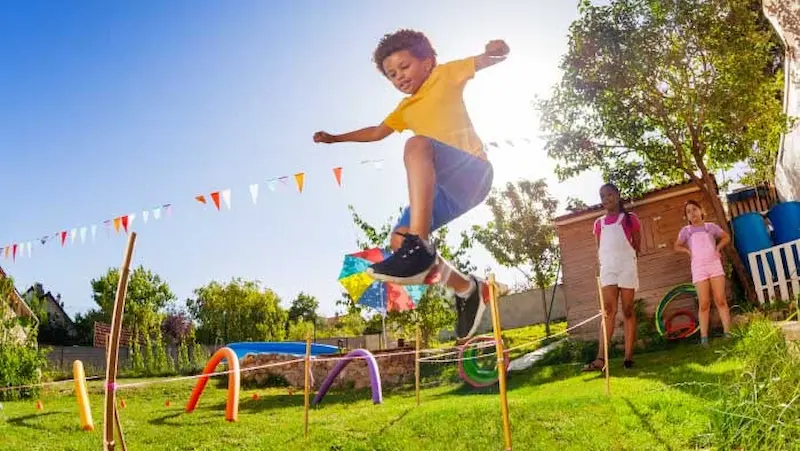
 We are an army of educators and passionate learners from BrightChamps family, committed to providing free learning resources to kids, parents & students.
We are an army of educators and passionate learners from BrightChamps family, committed to providing free learning resources to kids, parents & students.














